Kia EV5 Earth Long Range Review: To the top of Australia and down the other side in an EV
It sounded like a good idea at the time.
Drive a Kia EV5 Earth Long Range from Sydney to Melbourne via the Snowy Mountains. You know electric car in the hydro-electric heart of Australia and all that.
Well, I won’t keep you in suspense. We made it and we got a pretty good picture of the EV5’s capabilities along the way. Some other aspects of the experience weren’t as impressive though.
The car
The Kia EV5 is the first five-seat medium electric SUV from a legacy car manufacturer to go on-sale in Australia.
There are four models in the line-up and here we’re driving the Earth Long Range, which at $64,770 (plus ORCs) is the cheapest all-wheel drive and the second most expensive model overall.
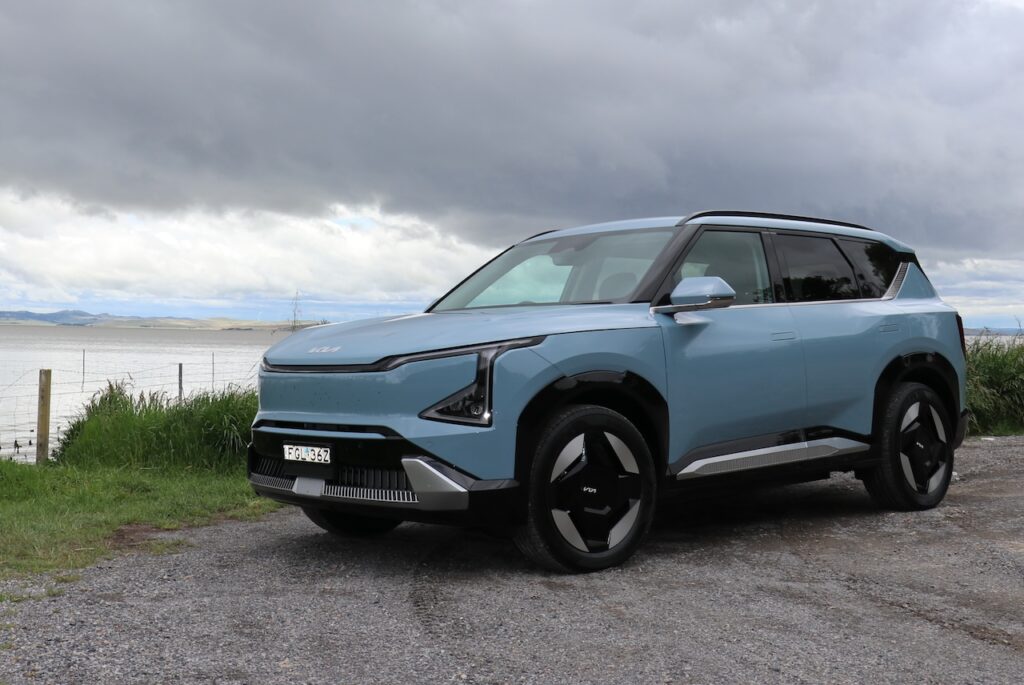
It employs a 230kW/480Nm dual e-motor powertrain hooked up to an 88.1kWh LFP (lithium iron phosphate) battery and claims a 20.1kWh (WLTP) consumption average and 500km range.
Its powertrain is a case of swings and roundabouts. LFP is less energy dense than NMC (Nickel Manganese Cobalt/lithium-ion) but it is much happier being DC fast-charged to 100 per cent than NMC. On a long run with many kays between chargers that helps.
However, the LFP chemistry and the EV5’s 400-volt electric architecture both contribute to a mediocre claimed 140kW maximum fast-charging rate.
Right, enough of the theory, let’s get into it.
READ MORE: 2025 Kia EV5: Why it’s a better buy than a Tesla Model Y | Opinion
READ MORE: 2024 Kia EV5 review: Believe the hype, this Model Y rival will give Tesla a run for its money in Australia
READ MORE: Take that Tesla! Kia EV5 pricing undercuts top-selling Model Y by thousands, setting the scene for a brutal mid-sized electric SUV battle
Sydney – Canberra
234km
23.8kWh/100km
Recharge: 31.01kWh @ 60c/kWh = $18.60
It’s a Saturday morning 9am and the opening leg is a soft hit-out along the Hume Freeway and then the Federal Highway between Australia’s population and political capitals.
The EV5 has easily swallowed our luggage and its plug and play parcel boards in the 513 litre boot help secure them. Up-front. We’ve got plenty of elbow stretching and junk-filing room as well.
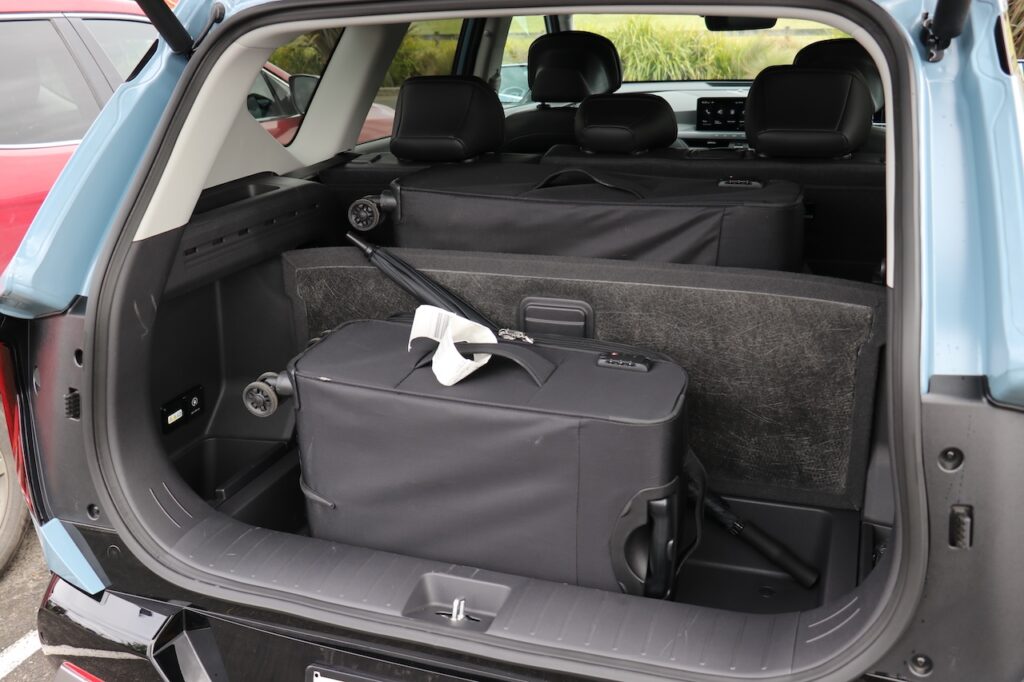
The drenching rain from the night before has gone as we tunnel our way out of Sydney. By the time we reach the western extremities we’re travelling under a mix of blue and fluffy white -a Simpsons sky.
Once the various bing bongs and assistants are dispensed with the EV5 settles into its quiet cruising stride.
We are in Eco mode to try and keep consumption to a minimum. In this steady state the graphic in the instrument panel shows drive only headed to the front wheels. Punchy Normal and aggro Sport powertrain modes are more prone to engaging the rear wheels.
With cruise control on the car’s software brain refuses to activate the regen paddles to increase energy claw-back.
It turns out we need all we can get. Electron-ing along at a steady 115km/h results in a 24.9kWh/100km average consumption rate. We’re also accounting for plenty of the local insect population, which are splattering themselves on the EV5’s blunt front.
The EV5 is far from the only EV with a solid nose. As they gain popularity will the fly population fall?
Other vehicles have accounted for plenty of Kangaroos and other fauna overnight. They lie sadly tangled on the roadside.
Despite its blocky shape, little wind or tyre noise is penetrating the EV5’s cabin. It’s riding comfortably too. This is its special talent – space and graceful cruising.
The boxy shape is misleading. We cruise past a Tesla Model Y that looks smaller but actually measures up bigger according to the tape.
Reaching Canberra we avail ourselves of a quick top-up at some chargers on the campus of the Australian National University.
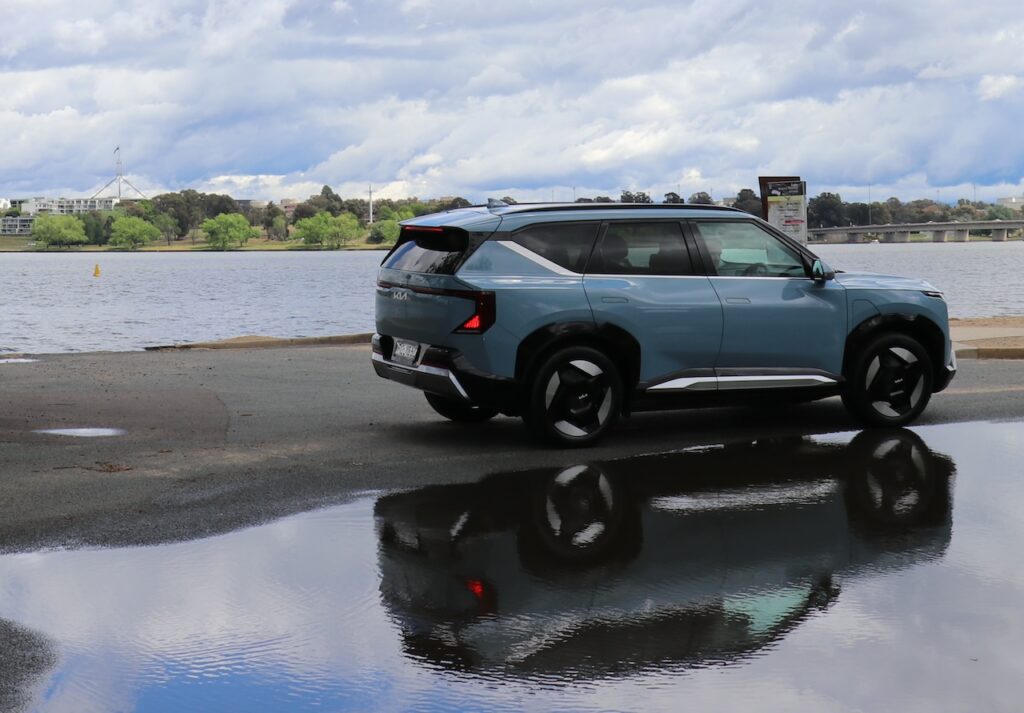
The chargers are allegedly rated at 160kW (according to the app), but the top readout we see is 87kW early on in our charge upwards from 21 per cent SOC.
With 31kW dumped in – enough to ensure we make it to Cooma – we power on.
Canberra – Cooma
115.5km
25.8kWh/100km
Recharge: 82.82kWh @ 65c/kWh = $53.83
The road turns single lane after the long crawl out of exurban Canberra. The Monaro Highway is usually straight and steady and occasionally winding as we climb upward.
The hills are slowly closing in and the grass turning white in stark contrast to the deep green poplars that dot the landscape.
The road is rougher, coarser, but more than acceptable by Australia’s awful standards. The EV5 Earth feels connected without being nasty.
It’s heavier and running on lower profile tyres than the single motor standard range Earth and that shows up in a jittery burr through the tyres and chassis to the driver. But it’s almost subliminal. Primary ride behaviour is still just fine,
Consumption is beyond 25kWh. I’m glad we topped up as much as we did in Canberra. And the steepest stuff is yet to come!
With 15 per cent battery charge remaining, the highlight of the drive is hooking up successfully to the Chargefox 350kW charger at the Snowy Hydro Centre in Cooma – it only takes two goes!
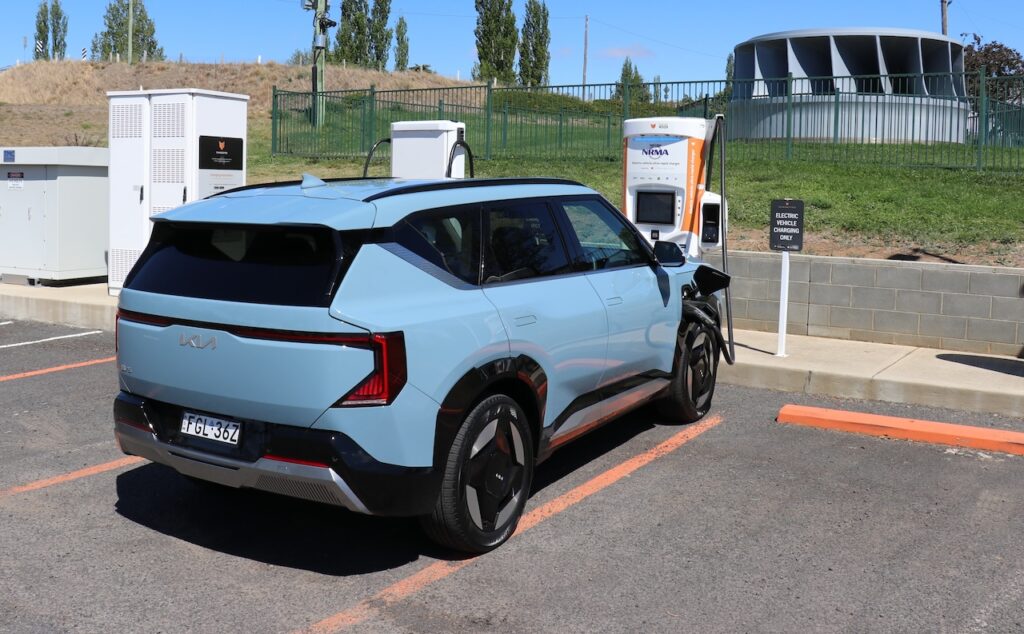
We had to recharge here because there’s nowhere really suitable to do so again until we reach our overnight stop on the far side of the climb across the Victorian border in Corryong.
The EV5 belies its stated limit, rocketing up to a 150kW charge rate. It soon starts declining again and according to the official Chargefox receipt we import 82.2kWh in just over an hour.
That gives us plenty of time to enjoy the toasties and coffee in the café and check out the giant turbine runner on display in the garden. Now that’s how you generate power!
Cooma – Corryong
202.7km
21.2kWh/100km
Recharge: 48.2620kWh @ 64c/kWh = $30.89
As we leave Cooma the battery says 100 per cent full, the range estimate is 417km if we don’t run air-con, 391km with.
Sweet cool air is blowing, sorry. It’s a lovely blue sky day, you couldn’t hope for better unless you’re trying to conserve charge in an EV.
We don’t fast recharge after the quick run to Jindabyne and then the steep, smooth, flowing and pretty climb to Thredbo. There’s nowhere to really do it anyway.
There’s a temptation to give the EV5 a bit of a crack along this road, but the need to conserve power is watering that desire down.
Going uphill the range estimator is dropping about 100km for every 50km we travel. On the brief downhills I experiment with switching off cruise and winding up the regenerative braking.
After a while I just leave it in Auto and let the car’s smarts look after us.
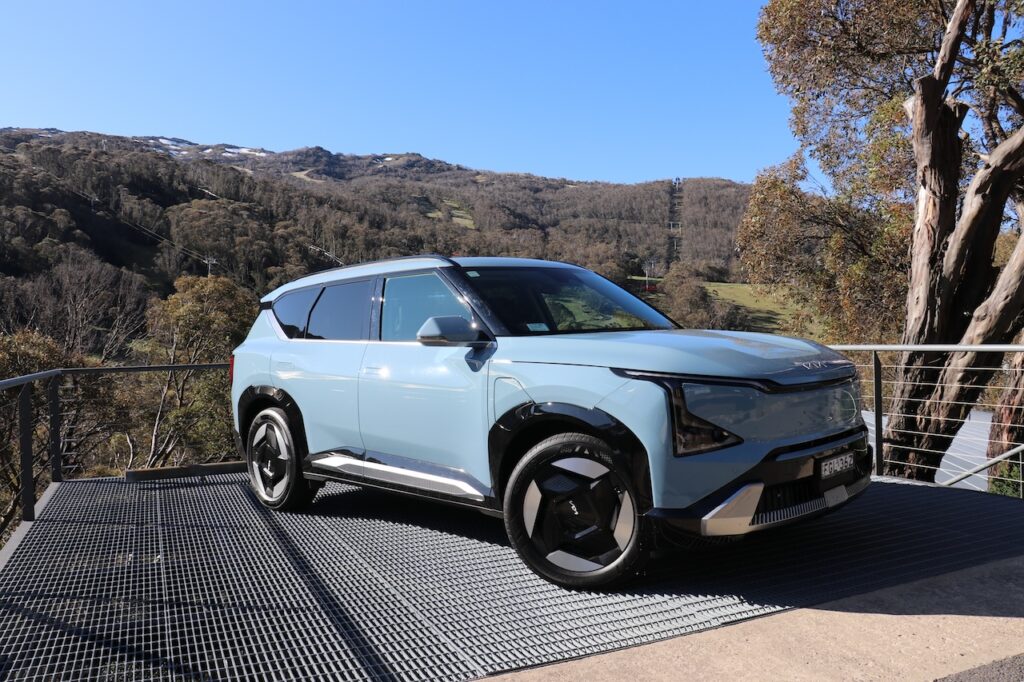
We stop for a quick photo in Thredbo village. There’s snow still speckling the far side of the valley where the ski slopes and mountain bike trails run. Mount Kosciuszko, Australia’s tallest mountain, is a few kays hike further in that direction.
Everything is quiet including us as we whisper out of village. We’ve reached the top of the Great Dividing Range (1580m) averaging 27.2kWh/100km. We’ve come 100km and the range is down to 248km (air-con on). Battery SOC is 68 per cent.
Now comes the descent. And it really is a fun descent. In the right car this would be a cracking sports drive, but really the most enjoyable bit today is watching the economy meter drop and drop and drop.
At 24.1km after our Thredbo departure the meter hits 0.0kWh/100km. Our range estimator says we’ve got 248km left in the battery. Battery SOC? Yep, 68 per cent!
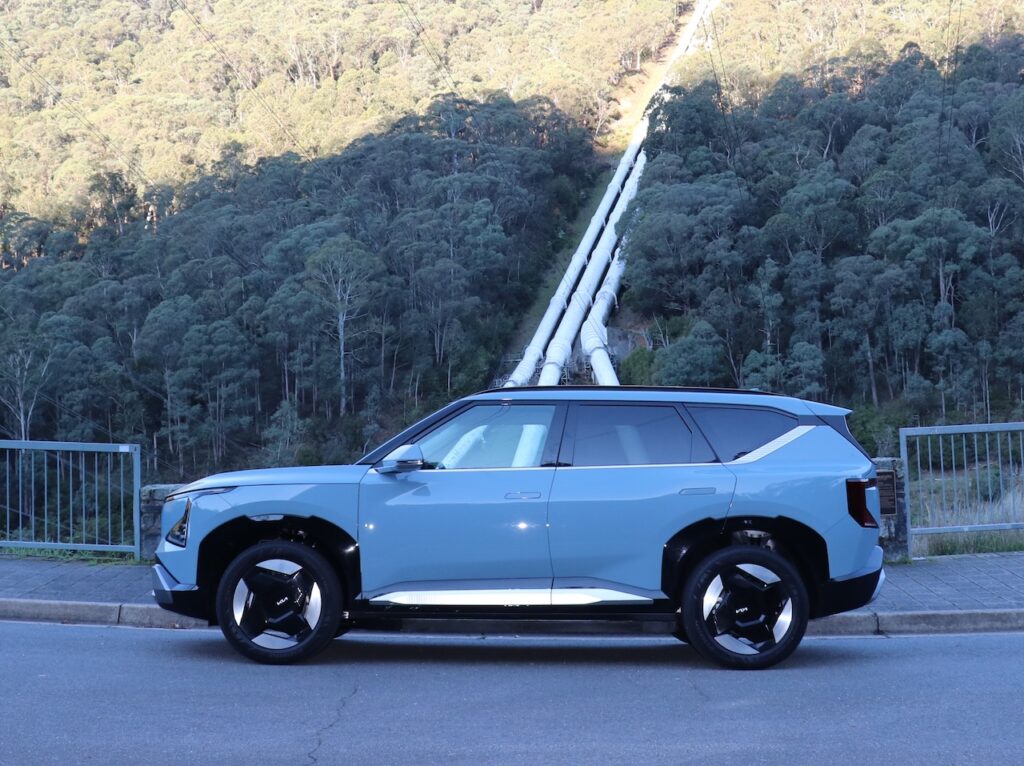
That hyper-miling stuff is fun!
By the time we cross the Murray River into Victoria and reach our overnight stop at Corryong the average has climbed back up to 15.8kWh/100km. Battery SOC is 49 per cent.
Time for a beer, which we drink at the local pub – and inhale a steak – as the EV5 recharges at the town’s only 50kW fast charger.
Corryong-Wodonga
132.2kmn
21.9kWh/100km
Recharge: N/A
Wodonga-Avenel
184.2km
24.1kWh/100km
Recharge: 84.454kWh @ 73c/kWh = $61.65
Our Sunday morning drive into Wodonga is a pleasant jaunt alongside the Hume Weir. Blue overhead and green surrounding blue alongside us.
The road is quiet and beautifully fast and flowing. The EV5 laps it up. However, we do notice more potholes than on the northern side of the border.
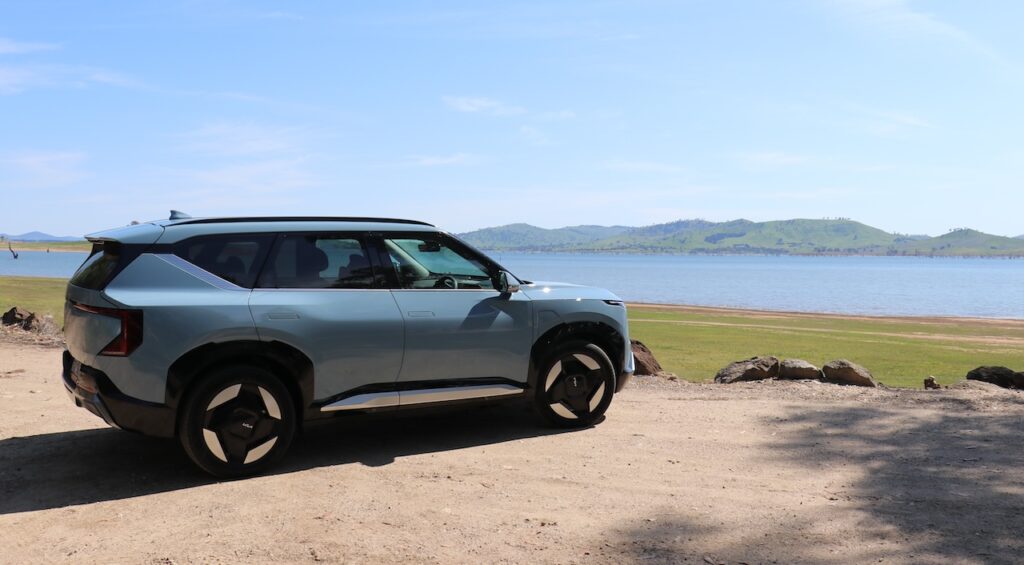
We don’t charge here but we do reset the tripmeter, because from here for a few hours it’s onto the Hume Freeway. It’s a drudge, but it has to be done
We head for the 350kW chargers at the Ampol roadhouse at Avenel. The app says only one charger is working so it’s a crap shoot whether we get there and have a long wait or not.
We don’t. But the family in the Polestar 2 who arrives just after us does. We watch as the diesel trucks and utes refuel and head on their way, as do the family loads of petrol SUVs. What infrastructure shortage?
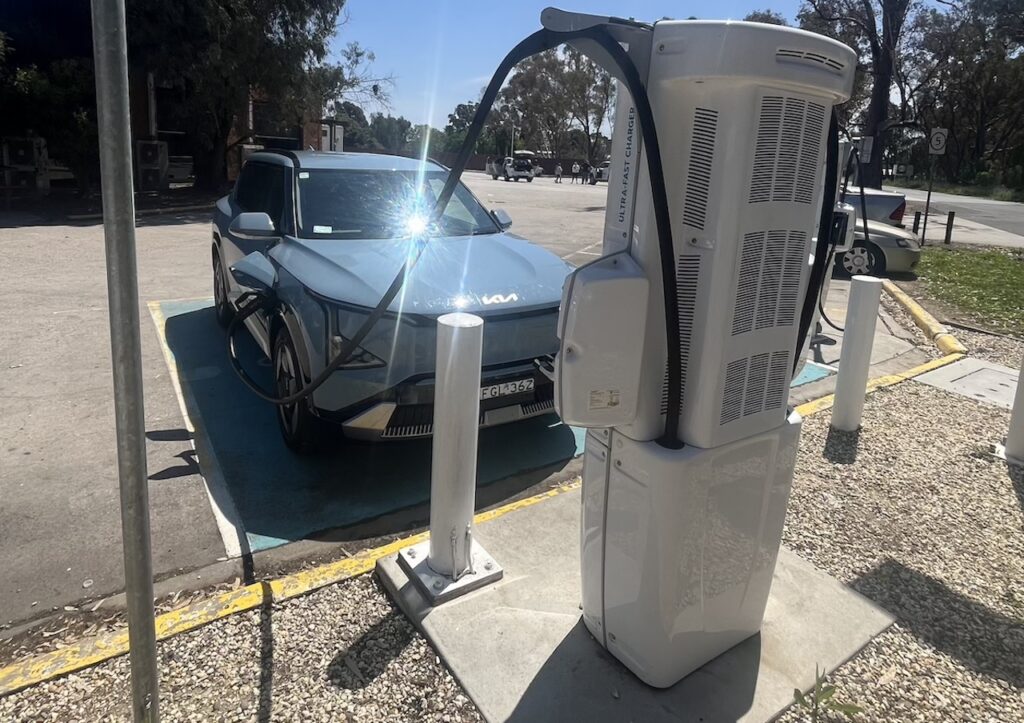
After a bit of mucking around the charger fires up – I quietly fist pump – and it delivers juice to the EV5 at a rate of up to 119kW. Not especially impressive – especially for the bloke in the Polestar!
What can we do but retire to the roadhouse and have some hot chips and a cold drink.
Avenel-Melbourne
209.1km
21.8kWh/100km
Turning off the freeway at Seymour we head for home on back roads. As we electric quietly by, a bloke is sitting on his porch in a Hi-Viz vest watching the traffic. That’s one form of Sunday afternoon entertainment out of footy season.
Then on to the country roads – one that’s wide and well surfaced is 80km/h for some reason. The next one is narrower, with less sightlines and more broken edges and it’s 100km/h. Victoria, the crazy state.
The EV5 feels relaxed on these roads. It’s heavy, it is designed to be a safe family transporter. Of course that EV response from zero to low throttle is a great asset that really is a winner.
Onto the Ring Road and welcome back to speed camera-crazed Melbourne traffic. People are three-wide across the freeway doing 101km/h. So frustrating!
But home is reached and our total is calculated. The average for the final section at 21.8kWh/100km indicates just how much the EV5 prefers broken throttle inputs and the chance to regen rather than high-speed freeway cruising. The 500km claim is more like 400km on a good day in the right driving environment.
Sydney-Melbourne
1120.9km
23kWh/100km
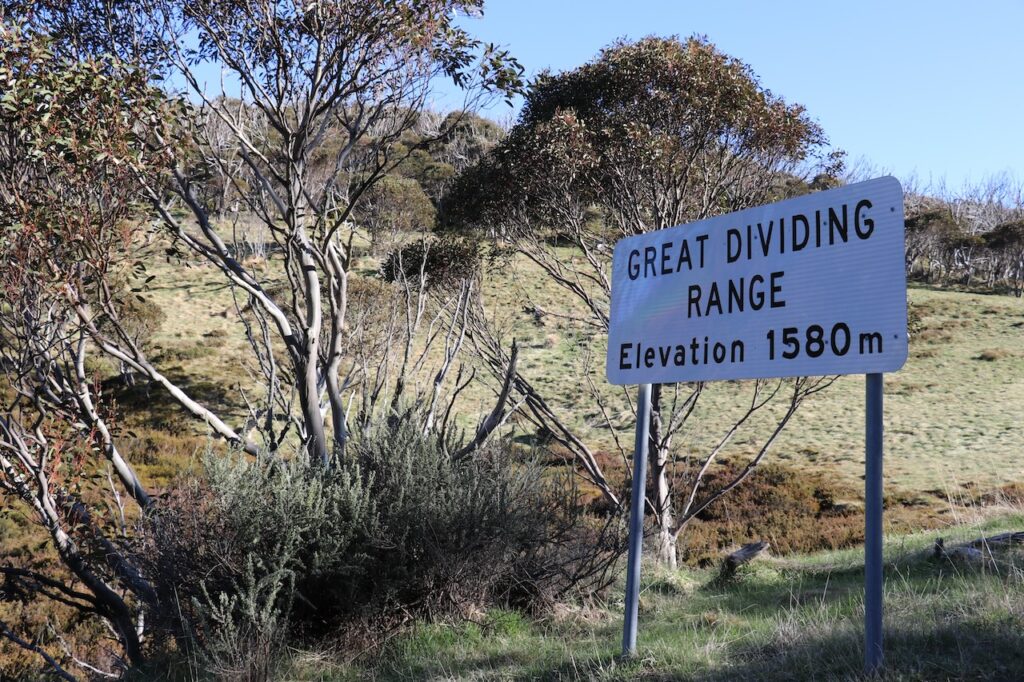
It’s been a great experience and an educative drive. Beautiful, stressful, peaceful, challenging.
Among many memories, there’s one in particular that is instructive.
On a Victorian country road a 70 Series Toyota issued a great plume of black smoke and lunged up the road ahead of us. It was as if he didn’t want to be overtaken by an EV.
A gentle prod of the EV5’s throttle kept us well within touch, and thankfully the dual-zone climate control kept us blocked from the pong and particulates.
Great performance, zero emissions, quiet, comfortable. On that score the EV5 and EV motoring are hard to argue with. But that 70 Series probably got home before us.
Because, on range and infrastructure when you’re travelling a long distance, EV is as yet, not so convincing.
Kia EV5 Earth Long Range specifications
Price: From $64,770 (plus on-road costs)
Basics: EV, 5 seats, 5 doors, midsize SUV, AWD
Range: 500km (WLTP)
Battery capacity: 88.1kWh
Battery warranty: 7 years/unlimited
Motor: 2 front and rear, 230kW/480Nm
AC charging: 11kW, Type 2 plug
DC charging: 140kW, CCS combo plug
0-100km/h: 6.1s

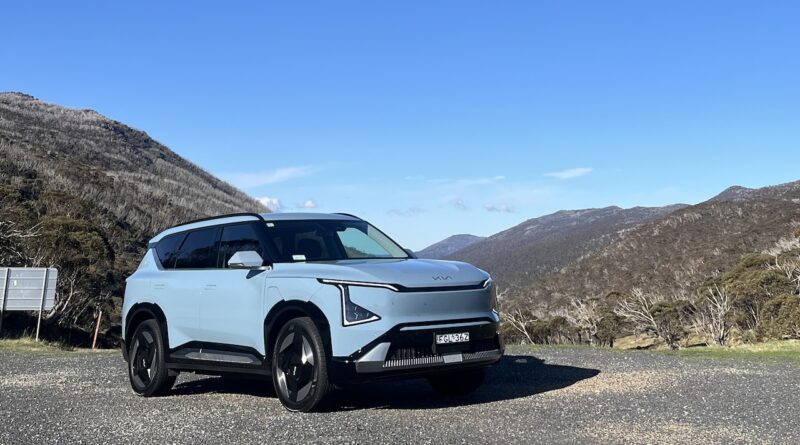
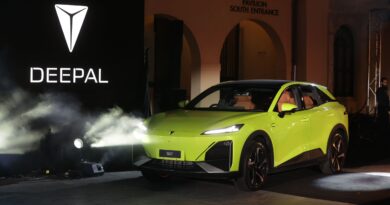
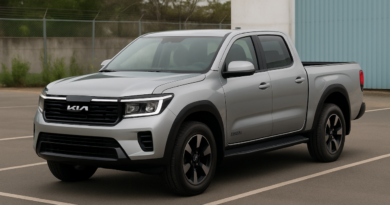
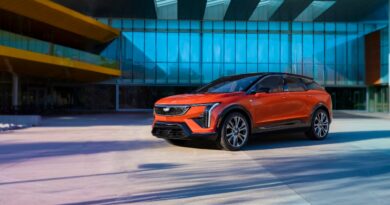
Great test! Car sounds good. Though regen on cruise control sounds like a worry. Does regen work at all on cruise control or does it just use the mechanical brakes, like the GWM Ora used to? That would be dire if that’s the case. I kind of expected you to make energy coming down off the mountains, but I might be being naive there. I’m interested in the EV3 when it arrives. Better be more efficient on the highway though.
It’s very important to understand the relationship between speed, aerodynamics, economy and recharging time.
Travelling at 110 kpH creates 21% more drag force than at 100 kpH. (Drag is proportional to the speed squared).
This basically means it will take longer to recharge the battery to travel the same distance.
However a more aerodynamic shape and 800 Volt architecture can helps a lot to increase range and reduce charging times more than you might expect.
As an example my Ioniq 6 averaged 17.6 kWH/100km at 110 real kpH (GPS speed) over a 1000 km trip, aircond on 21 degrees, and a very hot 38-40 outside. Still charged at over 200kW despite the heat, adding 200km of range in less than 12 minutes.
The less obvious, but real benefit, of efficiency comes when you only need to recharge from 20% – 80% to get safely to the next destination, rather than having to charge to 90% or even 100% 😔 just because your boxy SUV needs more percentage of charge to go the same distance.
The 20% – 80% (260 km) charge might take 20 minimum on a 150KW charger, (780 km/Hr).
The next 80% – 90% (43 km) extra charge might take 10 minutes, (258 km/Hr).
The final 90% – 100% (43 km) charge might take 15 minutes, (172 km/Hr).
So a 23.5 kW/100km energy consumption might mean waiting 45 minutes to recharge (20-100%), rather than 20 minutes (20-80%) for a 17.6 kW/100km vehicle on a 150kW charger. Obviously worse with a 50kW DC or 11KW AC charger.
Sometimes it can actually be faster to go 100kph, rather than 110kph on a long trip, if you will only have access to a slower charger to top-up along the way. (Please ALWAYS keep left unless overtaking and leave enough space in front of you for any passing vehicles to safely merge back in, so they only need to overtake one vehicle at a time).
PS. I found the ABRP app to be very helpful when planning long trips, especially when towing the caravan. The accuracy and options are impressive.
This comment is obviously from someone who understands realities of physics and has had experience in an EV. Faster isn’t always quicker. As someone who drives an MG4, which is not a box on wheels, I’m horrified by the 24 kWh/100km the reviewer measured for the trip. I could also go on about driving at 115kph when the speed limit is lower than that.
Interesting wonder how a Y would go ?
Could be worthwhile adding the cost of the charge as well if you have the receipts, and while you’re at it fix the typos 🙃
Wodonga-Avenel
184.2km
241.kWh/100km – decimal point ???
Avenel-Melbourne
209.1km
21.8L/100km litres ??
Thanks Jim, yeah – I’ll add those in good call.
Sorry about the tpyos (that’s a joek by the way).
Very interesting read – thanks Bruce! I’ve been seriously considering joining the EV world with my next car purchase, but the lack of charging infrastructure seems to still be a frustrating impediment on a long trip. Seems the stop-start advantages regenerative braking offers in urban areas makes a compelling case for EVs in our cities. But for long road trips like the one so well described here, it seems range anxiety remains a real concern given our relative slowness as a nation to provide the essential charging infrastructure. (Seems we’ve just wasted a decade waging culture wars about climate change instead of acting on the science and actively preparing for a zero emission future!). Even where there is a charger or two it seems they’re often either in use or not working!
Given these shortcomings and the massive catch-up deficit we have in terms of universally accessible charging, I can now reluctantly see why more and more people are choosing hybrids. Anything that continues the proliferation of burning fossil fuels – even at significantly reduced levels – is a compromise. But until we have reliable national infrastructure to make longs trips in an EV as easy as with an ICE vehicle, more energy efficient hybrids might be the way to go.
Thoughts?
Hi Paul, I have no hesitation in recommending EVs for the duties most of us do most of the time. Commuting and short runs. But every long journey I’ve ever done has had some issue – even if it’s simply the compromises you have to make to fit in with our inadequate public charging network. That along with battery peformance and cost is going to improve, it’s just a case of how long it is going to take.
Nothing has zero emissions
Seems again a very narrow story, Australia is a lot more than a limited drive on the east coast.
My wife has enough anxiety about everything in life for both of us so opted for a ICE for her new car. I haven’t driven interstate this century so I think I’ll be fine in an EV, certainly till retirement age, when I may consider hitting the road – but suspect charging facilities will be much better by then.